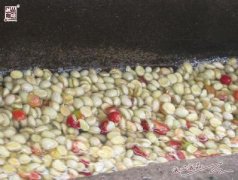The Origin of Coffee Coffee is traced back to the main producing countries.
The word Coffee [1] comes from the Greek word "Kaweh", which means "strength and passion". Coffee tree is an evergreen shrub of Capsaceae. Daily coffee is made from coffee beans combined with a variety of cooking utensils, and coffee beans refer to the nuts in the fruit of coffee trees, which are then roasted with appropriate roasting methods.
There are all kinds of legends about the origin of coffee, but most of them are forgotten because of its absurdity. However, people will not forget that Africa is the hometown of coffee. Coffee trees are likely to be found in Ethiopia's KAFFA province. Later, batches of slaves were sold from Africa to Yemen and the Arabian Peninsula, and coffee was taken everywhere along the way. To be sure, Yemen started growing coffee in the 15th century or earlier. Although Arabia had the busiest port city in the world at that time, it banned the export of any seeds. This barrier was finally broken through by the Dutch, and in 1616, they finally smuggled the surviving coffee trees and seeds to the Netherlands and began to grow them in greenhouses.
The source editor of coffee
One: the Story of the Shepherd
There are several legends about the origin of coffee, of which the more familiar is the story of the shepherd: according to Rothschild, a Roman linguist. Neroy (1613-1707) records: about the sixth century, when an Arab shepherd Caldai was herding sheep to the Isobian prairie, he was very excited and excited to see each goat. He found it strange after careful observation. The sheep were excited after eating some kind of red fruit. Cardai tasted some of the fruit curiously and found that the fruit was very sweet and delicious, and he felt very refreshed after eating it. From then on, he often went to eat this delicious fruit with the sheep. Later, a Muslim passed by and took some of this incredible red fruit home and distributed it to other parishioners, so its magical effect spread.
Number two: the Story of Shack Omar
Other legends are Shack, a disciple of Sheckaldi, the guardian saint of the Arabian Peninsula. Omar was a highly respected and beloved chief in Mocha, but was expelled by his people for committing crimes. As a result, Shake Omar was exiled to Osama in the country, where he stumbled upon the fruit of coffee in 1258. One day, Omar was walking hungry in the mountains and saw a bird with strange feathers on the branches, pecking at the fruit of the tree and making a very sweet cry. He took the fruit back and boiled it with water, only to emit a rich and attractive fragrance, and the original feeling of tiredness was eliminated after drinking it. Omar collected many of these magical fruits, and when she met someone who was sick, she made the fruit into soup for them to drink and refreshed her spirit. Because he did good everywhere and was loved by believers, his sins were soon forgiven, and when he returned to Mocha, he was praised for finding this fruit, and people did not worship him as a saint. At that time, the magic cure was said to be coffee.
Editors of major coffee producing countries
Coffee trees are very similar to laurel and usually grow between the Tropic of Cancer and the Tropic of Cancer.
A coffee tree usually grows for about three to four years before it begins to bear fruit. the fruit is a red berry and a small number of yellow berries. After drying and removing the pulp, the coffee beans can be separated.
There are shadows of coffee beans all over the world, and they can grow as usual as long as the climate is right. These suitable places for growing coffee beans are located between the Tropic of Cancer and the Tropic of Cancer, generally between 25 degrees north latitude and 30 degrees south latitude, covering most countries in Central Africa, East Africa, Middle East, India, South Asia, the Pacific, Latin America and the Caribbean, collectively referred to as the "coffee growth belt". Coffee production zone coffee is mainly concentrated in this area, because coffee is very vulnerable to frost, and the temperature and humidity in the tropics are the most suitable for coffee growth. Coffee beans grow into different species depending on farming methods, regional climate and various factors.
Classified editing of coffee
Coffee trees can be roughly divided into five types, of which Arabica and Robusta are more common. Arabica species, which account for more than 70% of the world's total output, are generally grown on slopes above 900 meters above sea level and are mostly found in tropical high-altitude areas such as Central and South America, East Africa, Southeast Asia and Hawaii. Its pleasant aroma, rich taste, and the tree needs more manual care, the stability of temperature and humidity in the climate is also higher, so the price is more expensive. Robaxter, which is highly adaptable to the environment, accounts for 30% of the world's total output. Its flavor is mediocre and bitter, and more importantly, the content of caffeine is 2 to 3 times that of Arabica. Generally grow on the slope of 200 to 600 meters above sea level, the requirement of manual care is very low, so the price is relatively low, mostly used for canned and instant coffee.
* Jamaica (West Indies)
Jamaica is a republic of large and small islands in the Caribbean. Coffee is grown on the slopes of the mountains on Hengduan Island. The producing area can be divided into three regions: BM (Blue Mountain) and HM (High Mountain) and PW (washed coffee beans in Pulai), which are also the brand names of coffee. The ranking of quality and price is ①, ② and ③, while the ranking of production is ③, ② and ①. Among them, the flavor, aroma, concentration and sour taste of "Blue Mountain" are all very average and have a high evaluation. Almost all the products are sold to Japan.

Important Notice :
前街咖啡 FrontStreet Coffee has moved to new addredd:
FrontStreet Coffee Address: 315,Donghua East Road,GuangZhou
Tel:020 38364473
- Prev

What are the main coffee producing areas in the world?
India is a country dominated by tea, but its coffee production is among the highest in the world, and it has both Robusta and Arabica. It is also one of several countries that have water washing and daily treatment at the same time. The region of Indian coffee is mainly from the West Gaozhi Mountains in southern India to the Arabian Sea.
- Next

How to treat Yunnan coffee beans
As harvest season draws to a close, I would like to add an overview of the coffee processing process. In this blog post, I will introduce you to the wet processing steps after coffee picking in Yunnan. After harvest, the berries are either sent directly to a pulp collector (if the harvest is done well) or collected in a siphon tank filled with water. Berries are here.
Related
- Does Rose Summer choose Blue, Green or Red? Detailed explanation of Rose Summer Coffee plots and Classification in Panamanian Jade Manor
- What is the difference between the origin, producing area, processing plant, cooperative and manor of coffee beans?
- How fine does the espresso powder fit? how to grind the espresso?
- Sca coffee roasting degree color card coffee roasting degree 8 roasting color values what do you mean?
- The practice of lattes: how to make lattes at home
- Introduction to Indonesian Fine Coffee beans-- Java Coffee producing area of Indonesian Arabica Coffee
- How much will the flavor of light and medium roasted rose summer be expressed? What baking level is rose summer suitable for?
- Introduction to the characteristics of washing, sun-drying or wet-planing coffee commonly used in Mantenin, Indonesia
- Price characteristics of Arabica Coffee Bean Starbucks introduction to Manning Coffee Bean Taste producing area Variety Manor
- What is the authentic Yega flavor? What are the flavor characteristics of the really excellent Yejasuffi coffee beans?

